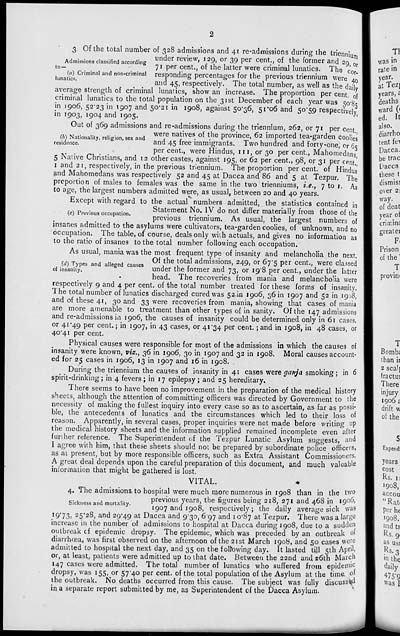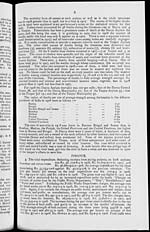Medicine - Mental health > 1903-1911 - Triennial report on the lunatic asylums in the province of Eastern Bengal and Assam > 1906, 1907, 1908 - Triennial report on the lunatic asylums in the province of Eastern Bengal and Assam for the years 1906, 1907, & 1908
(124) Page 2
Download files
Individual page:
Thumbnail gallery: Grid view | List view

2
Admissions classified according
to—
(a) Criminal and non-criminal
lunatics.
3 Of the total number of 328 admissions and 41 re-admissions during the triennium
under review, 129, or 39 per cent., of the former and 29, or
71 per cent., of the latter were criminal lunatics. The cor-
responding percentages for the previous triennium were 40
and 45, respectively. The total number, as well as the daily
average strength of criminal lunatics, show an increase. The proportion per cent. of
criminal lunatics to the total population on the 31st December of each year was 50.85
in 1906, 52.23 in 1907 and 50.21 in 1908, against 50.36, 51.06 and 50.59 respectively,
in 1903, 1904 and 1905.
(b) Nationality, religion, sex and
residence.
Out of 369 admissions and re-admissions during the triennium, 262, or 71 per cent.,
were natives of the province, 62 imported tea-garden coolies
and 45 free immigrants. Two hundred and forty-one, or 65
per cent., were Hindus, 111, or 30 per cent., Mahomedans,
5 Native Christians, and 12 other castes, against 195, or 62 per cent., 98, or 31 per cent.,
1 and 21, respectively, in the previous triennium. The proportion per cent. of Hindus
and Mahomedans was respectively 52 and 45 at Dacca and 86 and 5 at Tezpur. The
proportion of males to females was the same in the two trienniums, i.e., 7 to 1. As
to age, the largest numbers admitted were, as usual, between 20 and 40 years.
(c) Previous occupation.
Except with regard to the actual numbers admitted, the statistics contained in
Statement No. IV do not differ materially from those of the
previous triennium. As usual, the largest numbers of
insanes admitted to the asylums were cultivators, tea-garden coolies, of unknown, and no
occupation. The table, of course, deals only with actuals, and gives no information as
to the ratio of insanes to the total number following each occupation.
(d) Types and alleged causes
of insanity.
As usual, mania was the most frequent type of insanity and melancholia the next.
Of the total admissions, 249, or 67.5 per cent., were classed
under the former and 73, or 19.8 per cent., under the latter
head. The recoveries from mania and melancholia were
respectively 9 and 4 per cent. of the total number treated for these forms of insanity.
The total number of lunatics discharged cured was 52 in 1906, 36 in 1907 and 52 in 1908,
and of these 41, 30 and 33 were recoveries from mania, showing that cases of mania
are more amenable to treatment than other types of in sanity. Of the 147 admissions
and re-admissions in 1906, the causes of insanity could be determined only in 61 cases,
or 41.49 per cent. ; in 1907, in 43 cases, or 41.34 per cent. ; and in 1908, in 48 cases, or
40.41 per cent.
Physical causes were responsible for most of the admissions in which the causes of
insanity were known, viz., 36 in 1906, 30 in 1907 and 32 in 1908. Moral causes account-
ed for 25 cases in 1906, 13 in 1907 and 16 in 1908.
During the triennium the causes of insanity in 41 cases were ganja smoking ; in 6
spirit-drinking; in 4 fevers; in 17 epilepsy ; and 25 hereditary.
There seems to have been no improvement in the preparation of the medical history
sheets, although the attention of committing officers was directed by Government to the
necessity of making the fullest inquiry into every case so as to ascertain, as far as possi-
ble, the antecedents of lunatics and the circumstances which led to their loss of
reason. Apparently, in several cases, proper inquiries were not made before writing up
the medical history sheets and the information supplied remained incomplete even after
further reference. The Superintendent of the Tezpur Lunatic Asylum suggests, and
I agree with him, that these sheets should not be prepared by subordinate police officers,
as at present, but by more responsible officers, such as Extra Assistant Commissioners.
A great deal depends upon the careful preparation of this document, and much valuable
information that might be gathered is lost.
VITAL.
Sickness and mortality.
4. The admissions to hospital were much more numerous in 1908 than in the two
previous years, the figures being 218, 271 and 468 in 1906,
1907 and 1908, respectively; the daily average sick was
19.73, 25.28, and 29.49 at Dacca and 9.30, 6.97 and 10.87 at Tezpur. There was a large
increase in the number of admissions to hospital at Dacca during 1908, due to a sudden
outbreak of epidemic dropsy. The epidemic, which was preceded by an outbreak
diarrhœa, was first observed on the afternoon of the 21st March 1908, and 50 cases were
admitted to hospital the next day, and 35 on the following day. It lasted till 5th April,
or, at least, patients were admitted up to that date. Between the 22nd and 26th March
147 cases were admitted. The total number of lunatics who suffered from epidemic
dropsy, was 155, or 57.40 per cent. of the total population of the Asylum at the time of
the outbreak. No deaths occurred from this cause. The subject was fully discussed
in a separate report submitted by me, as Superintendent of the Dacca Asylum.
Set display mode to: Large image | Zoom image | Transcription
Images and transcriptions on this page, including medium image downloads, may be used under the Creative Commons Attribution 4.0 International Licence unless otherwise stated. ![]()
| Permanent URL | https://digital.nls.uk/83166669 |
|---|



![[Page 1]](https://deriv.nls.uk/dcn4/8316/83166668.4.jpg)
